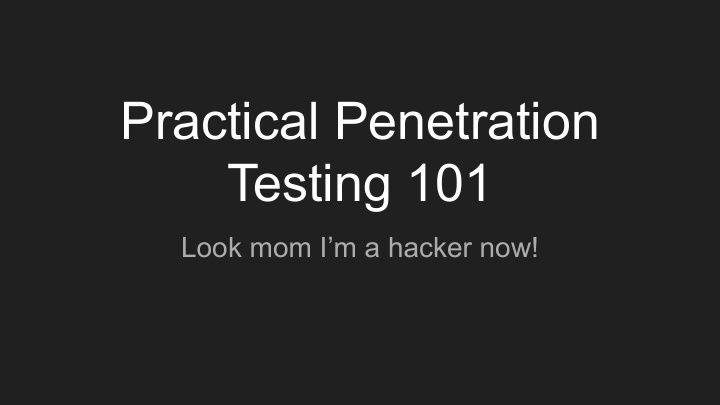



Practical Penetration Testing 101 Look mom I’m a hacker now!
Words of warning ● Anything you do to a remote system without authorization is illegal ● Use common sense ● Federal prison is bad
Overview of Today ● Brief overview of the cyber kill chain ● We will be attempting to exploit a live system and relate that back to the cyber kill chain
Cyber Kill Chain
1- Reconnaissance ● Scans will be performed on a target’s network ● Use tools such as nmap ● Osint- Open-source intelligence Scanning Social media, Google Hacking, ect.
2 - Intrusion ● This is a point of entry for an attack ● Most commonly done through phishing or MiM attack
3 - Exploitation ● This is where an attacker will attempt to exploit a physical system on the network beyond the perimeter ● The attacker will use the system they are on to pivot to other boxes on the network
4 - Privilege Escalation ● An attacker will use vulnerabilities/misconfigurations on a box to gain “root” or administrator access ● All about elevating the attackers permissions, for example on a windows network the main goal would be domain controller
5 - Lateral Movement ● An attacker will then try to pivot across the network to other boxes and other subnets ● The attacker will also look out for sensitive PII
6 - Obfuscation ● Naturally, the attacker will try to hide their presence ● They will use timestoping, redirect logs, and removing data to do so
7 - Denial of Service ● Next an attacker will bring down the entire network ● This is done because it can cause harm to the infiltrated organization Uptime = $$$ Imagine if this was done to Amazon
8 - Exfiltration ● An attacker will then cover their tracks and exit the network with all the stolen information ● What happens with this information depends on the attacker ● The attacker may leave behind backdoors
Live Demo Now the fun part!
Recommend
More recommend